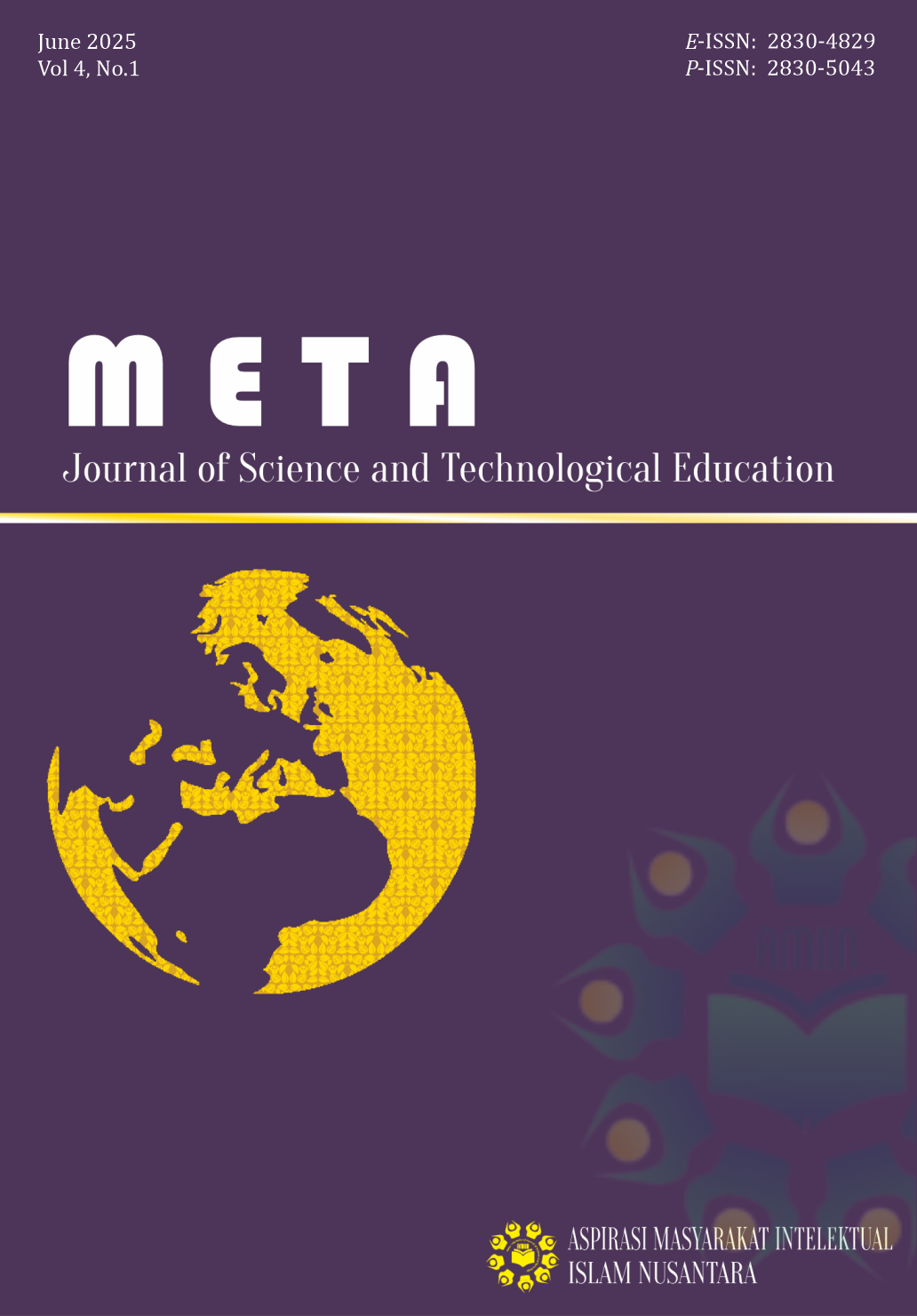Students' Data Collection, Graph-Making, and Conclusion-Making Skills in Inquiry-based Learning Using Interactive Simulations
Keywords:
Conclusion Making, Data Collection, Force and Motion, Graph Making, Inquiry, PhET Simulation, WorksheetAbstract
This study investigates students' skills in data collection, graph-making, and conclusion-making during a basic physics course on force and motion using worksheet-integrated PhET simulations. Sixteen students at IAIN Kerinci were selected through total population sampling. Worksheets were designed to guide students through three investigative tasks: examining the effects of resultant forces, exploring the relationship between mass and acceleration under constant force, and analyzing the relationship between force and acceleration under constant mass. Quantitative descriptive and correlational methods were employed to evaluate and analyze students’ skill levels and relationships between the skills. Results indicate that students excel in data collection, achieving consistent and high scores, but face challenges in graph construction and conclusion-making, as evidenced by higher variability and errors. Significant misconceptions, such as misunderstanding the conditions of zero resultant force and acceleration, were identified. Correlational analysis revealed a strong, positive relationship between data collection and graph-making skills, but no significant correlation with conclusion-making skills. Regression analysis suggested limited predictive ability of the foundational skills for inferential reasoning. The findings underscore the need to focus on enhancing graph-making and pattern-identification processes to support conclusion-making. This research highlights critical areas for improving physics education and developing scientific reasoning skills.
References
Beeken, P. (2014). Graphing Reality. The Physics Teacher, 52(8), 497–499. https://doi.org/10.1119/1.4897591
Bell, R., Smetana, L., & Binns, I. (2005). Simplifying inquiry instruction. The Science Teacher, October(October), 30–33.
Cohen, J. (1988). Statistical Power Analysis for the Behavioral Science. Second Edition. Lawrence Erlbaum Associates.
Edelson, D. C. (2001). Learning-for-Use: A framework for the design of technology-supported inquiry activities. Journal of Research in Science Teaching, 38(3), 355–385. https://doi.org/10.1002/1098-2736(200103)38:3<355::AID-TEA1010>3.0.CO;2-M
Kosso, P. (2011). A Summary of Scientific Method. Springer. papers3://publication/uuid/9B609610-9D62-4292-9383-300771A6B79B
Moore, E. B., & Perkins, K. K. (2018). Advances in PhET interactive simulations: Interoperable and accessible. Cyber-Physical Laboratories in Engineering and Science Education, 141–162. https://doi.org/10.1007/978-3-319-76935-6_6
Morgan, G. A., Leech, N. L., Gloeckner, G. W., & Barret, K. C. (2004). SPSS for Introductory Statistics. Use and Interpretation. Lawrence Erlbaum Associates, Inc. All.
National Research Council. (2012). A Framework for K-12 Science Education: Practices, Crosscutting Concepts, and Core Ideas. The National Academies Press.
Pedro, M. S. (2013). Real-time assessment, prediction, and scaffolding of middle school students’ data collection skills within physical science simulations. In Worcester Polytechnic Institute, Worcester. https://web.wpi.edu/Pubs/ETD/Available/etd-042513-062949/
Perkins, K. (2020). Transforming STEM Learning at Scale: PhET Interactive Simulations. Childhood Education, 96(4), 42–49. https://web.wpi.edu/Pubs/ETD/Available/etd-042513-062949/
Pranata, O. D. (2023a). Enhancing Conceptual Understanding and Concept Acquisition of Gravitational Force through Guided Inquiry Utilizing PhET Simulation. Saintek: Jurnal Sains Dan Teknologi, 15(1), 44–52. https://doi.org/10.31958/js.v15i1.9191
Pranata, O. D. (2023b). Physics Education Technology (PhET) as Confirmatory Tools in Learning Physics. Jurnal Riset Fisika Edukasi Dan Sains, 10(1), 29–35. https://doi.org/10.22202/jrfes.2023.v10i1.6815
Pranata, O. D. (2024). Students’ Data Collection and Conclusion-Making Skills Through Inquiry Using Worksheet-Based PhET Simulation : Projectile Motion. International Conference on Mathematics and Physics Education, May, 60–74. http://pma.uin.ar-raniry.ac.id/index.php/id/posts/proceeding-the-1st-international-conference-on-mathematics-and-physics-learning
Pranata, O. D. (2025a). Peer Instruction and PhET Simulations: Strengthening Students’ Understanding of Motion. The Proceedings of the International Conference on Physics Education (ICONPYEDU), 1, 1–9. https://doi.org/https://doi.org/10.20415/iconphyedu.v1i1.71
Pranata, O. D. (2025b). Analysis of vector concept understanding and its correlation with basic mathematical abilities of prospective science teachers. Contemporary Mathematics and Science Education, 6(1), ep25001. https://doi.org/10.30935/conmaths/15723
Pranata, O. D., & Noperma, N. (2023). Critical Thinking Skills in Rotational Dynamics : Learning Physics With and Without Free-body Diagrams. Tarbawi : Jurnal Ilmu Pendidikan, 19(2), 153–164. https://doi.org/10.32939/tarbawi.v19i2.4215
Pranata, O. D., Seprianto, S., Adelia, I., Darwata, S. R., & Noperta, N. (2022). Science Outreach at Madrasa Menggunakan Simulasi PhET (Physics Education Technology). RANGGUK: Jurnal Pengabdian Kepada Masyarakat, 02(02), 1–9.
Putri, M. T., & Pranata, O. D. (2024). Merdeka Curriculum Implementation at Secondary Schools : Science Teachers’ Perspective. IJECA (International Journal of Education and Curriculum Application), 7(3), 331–345. https://doi.org/10.31764/ijeca.v7i3.26282
Staddon, J. (2018). Scientific method: How science works, fails to work, and pretends to work. In Scientific Method: How Science Works, Fails to Work, and Pretends to Work. Routledge.
Wenning, C. J. (2011a). Experimental Inquiry in Introductory Physics Course. Journal of Physics Teacher Education, 6(2), 2–8.
Wenning, C. J. (2011b). The Levels of Inquiry Model of Science Teaching. J. Phys. Tchr. Educ. Online, 6(2), 9–16.
Whitacre, I., Hensberry, K., Schellinger, J., & Findley, K. (2019). Variations on play with interactive computer simulations: balancing competing priorities. International Journal of Mathematical Education in Science and Technology, 50(5), 665–681. https://doi.org/10.1080/0020739X.2018.1532536
Wieman, C. E., & Perkins, K. K. (2006). A powerful tool for teaching science. Nature Physics, 2(5), 290–292. https://doi.org/10.1038/nphys283
Winter, J. de, & Hardman, M. (2020). Teaching Secondary Physics. In J. de Winter & M. Hardman (Eds.), Teaching Secondary Science (3rd ed.). https://books.google.com.my/books?id=ZSoryQEACAAJ
Woolnough, J. (2000). How do students learn to apply their mathematical knowledge to interpret graphs in physics? Research in Science Education, 30(3), 259–267. https://doi.org/10.1007/BF02461633
Downloads
Published
How to Cite
Issue
Section
License
Copyright (c) 2025 META: Journal of Science and Technological Education

This work is licensed under a Creative Commons Attribution 4.0 International License.











